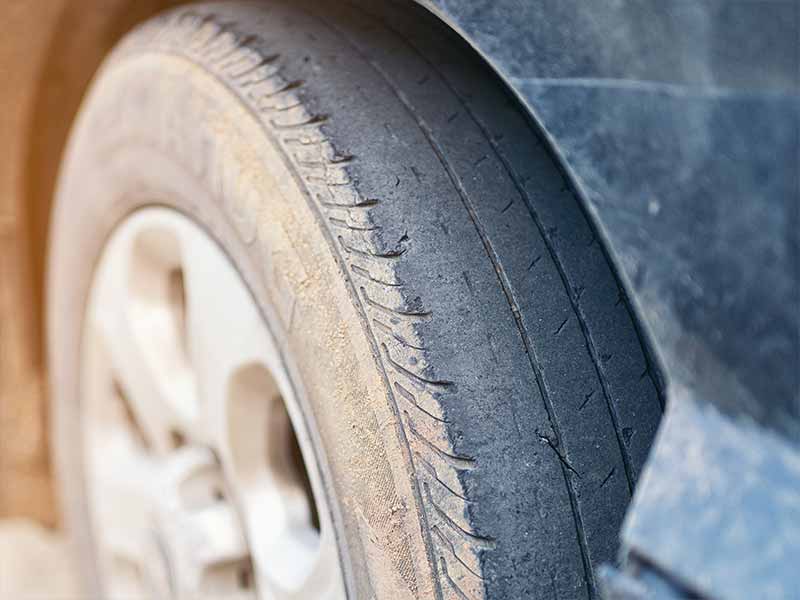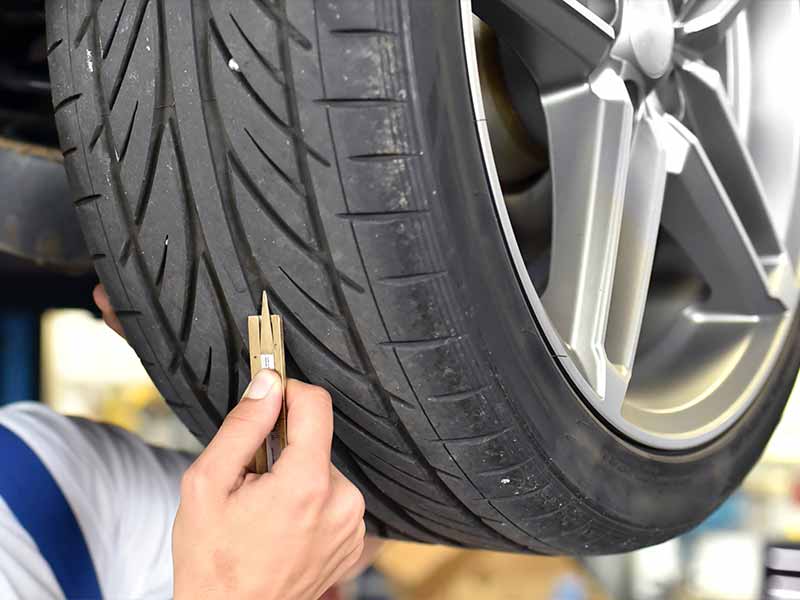Regular tire rotation is important for many reasons, but one of the most important is to maintain your tire warranty. Tire manufacturers provide tire warranties for most tires and guarantee that the tires will last a certain amount of miles.
To maintain this warranty you need to follow all of the requirements the tire manufacturer has for maintaining the tire warranty. Usually, the main requirement is having your tires rotated regularly.
Is It OK To Rotate Tires Every 10,000 miles?
10,000 miles is usually too long to wait between tire rotations to meet the requirements of your tire warranty. Most tire warranties will require rotation no later than 8,000 miles but most require shorter intervals than that.
Rotating tires every 5,000 miles will usually meet or exceed the requirements to maintain your tire warranty.
You should check the documentation provided with your tires to make sure that you are meeting all of the requirements to be sure you don’t void your warranty.
Let’s go over the details of regular rotation and what you can expect.

How Often Should You Rotate Your Tires?
You should rotate your tires at or before the mileage requirement for maintaining your tire warranty.
Every 10,000 miles is usually too long to wait to rotate the tires. Most tire manufacturers will require tire rotation between 5,000 and 8,000 miles.
I recommend rotating tires every 5,000 miles since this will usually exceed the requirement to maintain your warranty and gives you a little buffer if you try to schedule a tire rotation along with another maintenance service.
Do You Need To Rotate Tires Every 5000 Miles?
Tires don’t typically need to be rotated every 5,000 miles, but it will usually meet or exceed the requirement to maintain your tire’s mileage warranty. Most tire warranties require slightly longer rotation intervals.
I recommend 5,000 mile tire rotating to provide a little buffer when trying to schedule rotations with other maintenance services.
More frequent tire rotation is not just beneficial for ensuring your tires wear evenly. Getting eyes on your tires on a regular basis can help spot minor problems before they become big issues.
Tires slowly drift out of balance as they wear and suspension components can suffer damage from potholes and curb strikes that can affect alignment. Uneven wear is usually an early sign of balance and alignment problems.
Balance and alignment issues can lead to steering wheel vibrations, excessive tire noise, and a rough ride in addition to all the tires becoming worn and costing money to replace.
Can You Rotate Tires Too Often?
You can’t rotate tires too often, but you should try to keep the mileage between tire rotations similar. If you have drastically different intervals between when your tires are rotated you can lose much of the benefits.
It makes sense to try to combine a rotation service with other vehicle maintenance services when possible. It will save you time not having to wait for your car or truck and can help you save money.
Tire rotation used to be recommended to be performed with every oil change for instance. Now, advances with synthetic oils and engine designs have made oil change intervals longer and waiting that long may not meet the requirement to maintain your tire’s warranty.
Some cars and trucks on the road are recommended to have their oil changes performed every 3,000 miles. This is not too often to rotate the tires. It will even better ensure even tire wear.
When Not To Rotate Tires?
There aren’t many reasons to not have your tires rotated, but there are some situations where it isn’t recommended or even possible.
Let’s go over the details of what situations your tires shouldn’t be rotated.
Directional Tires & Staggered Wheels
If you have both directional tread on you tires and staggered wheels, you will not be able to rotate your tires. Tires with directional tread can only be rotated front to rear. Staggered wheels can only be rotated side to side. When a car or truck has both a directional tread pattern and staggered wheels, tire rotation is no longer possible.

Directional Tread
Directional tread, as the name implies, is designed to only work when spinning in one direction only. Once a directional tire is mounted onto a wheel, it can only be used on one side of your car or truck. If you try to move it to the other side it will spin in reverse and create an extremely dangerous situation, especially in wet weather conditions.

Staggered Wheels
Staggered wheels are wheels that are different sizes on the front axle and rear axle of your car or truck. This is common on sports cars for instance. Many rear drive sports cars will have wider wheels and tires on the rear to help reduce oversteer and increase traction.
This situation requires that the wheels remain on the same axle. The wider rear tires and wheels can not be moved to the front axle location without drastically negatively affecting handling. Often there isn’t enough clearance to even attempt this.
Tires With 4/32″ Tread Left
You shouldn’t rotate your tires if the tread on any tire that will be moved to the rear will have 4/32″ of tread depth or less. This can be more dangerous that leaving tires with such little tread wear left on the front.
Tires with 4/32″ of tread depth or less should be replaced as soon as possible. Tires with 2/32″ of tread should no longer be used and need to be replaced immediately.
How To Rotate Your Tires
Tire rotation is done by jacking up your vehicle and placing it on jack stands. Once securing lifted, you remove your wheels and then remount them at different positions around the car or truck.
Tire rotation is a fairly simple tire maintenance task but it is best to have it done by your local mechanic or tire shop. The reason is that you can usually have the service performed for free when combined with another regular maintenance service.
Also, it is important to have lug nuts torqued to the vehicle manufacturer’s specification to prevent warping of brake rotors or damage to lug nuts or lug studs. A torque wrench is required to properly tighten the lug nuts to the manufacturer’s requirement.
Tire Rotation Pattern
Tire rotation patterns are mostly depending upon which axle is used to propel the vehicle forward. Directional tires and staggered wheels limit the ability to use tire rotation patterns that are specific to driven wheels, unfortunately. But otherwise, the following are best practices for tire rotation patterns.
Front Wheel Drive
Front wheel drive cars are extremely harsh on tires. The front wheels do double-duty as steering traction and acceleration traction. This causes them to wear down very quickly and often with uneven wear.
If the tires of front wheel drive cars and trucks aren’t regularly rotated, the uneven wear will shorten their life even more quickly.
Forward Cross Tire Rotation
The forward cross tire rotation pattern moves the rear tires forward and across the vehicle to the opposite sides. The front tires move to the rear and remain on the same side.
Rear Wheel Drive
Rear wheel drive vehicles are more punishing on the rear. The front tires still take some abuse however.
Rearward Cross Tire Rotation
The rearward cross tire rotation pattern moves the front wheels rearward and across to the opposite sides of the vehicle. The rear wheels move forward and remain on the same side of the car or truck.
All Wheel Drive
All wheel drive cars and trucks do a better job of balancing tire wear evenly between the front tires and rear tires, but this varies depending on the design of the drive system.
X-Pattern
The X-pattern of tire rotation swaps the front and rear tires across the car or truck. The left front tire moves to the right rear. The right front tire moves to the left rear tire location. The rear wheels move to the front and swap sides.
These aren’t the only patterns that can be used and you should refer to your car or truck owner’s manual for which pattern will help you get the most out of your four tires.
Final Thoughts
Tires wear unevenly between front and rear tires. This uneven wear will shorten the life of your tires unless you can even it out with regular tire rotation.
Tire manufacturers also require that your tires be rotated regularly to ensure your tires wear properly and last as long as possible. If you don’t have your tires rotated according to their specification they will not honor the tire mileage guarantee.
You should always be sure to rotate tires at least as often as required, but I recommend tires rotate every 5,000 to provide a little extra buffer so you can try to schedule having your tires rotated with another maintenance service.
Resources
Below are some links you may find helpful when learning about tires





